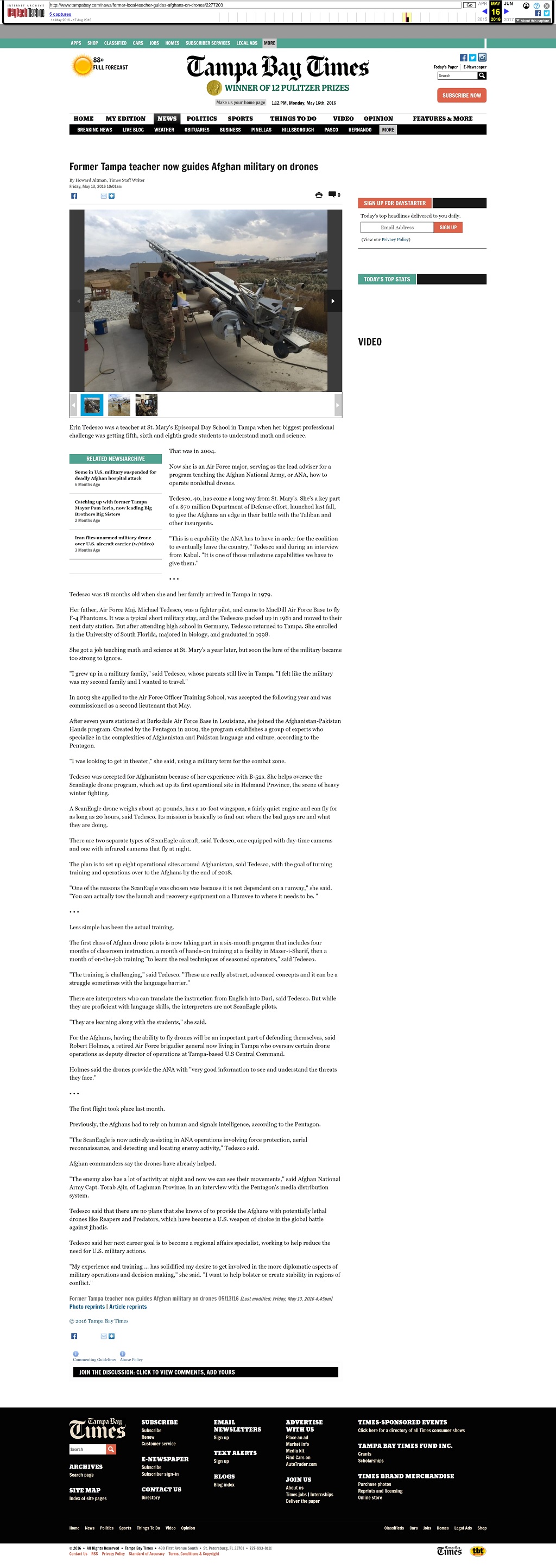
News / Military
By Howard Altman / Tampa Bay Times / May 13, 2016
PHOTO: Air Force Maj. Erin Tedesco, a former Tampa school teacher, looking at the ScanEagle drone catapult launching system. Tedesco, 40, is the lead advisor to the program teaching the Afghan National Army how to use the aircraft to gather images and help the Afghans defend themselves. (Special to the Times)
Erin Tedesco was a teacher at St. Mary’s Episcopal Day School in Tampa when her biggest professional challenge was getting fifth, sixth and eighth grade students to understand math and science.
That was in 2004.
Now she is an Air Force major, serving as the lead adviser for a program teaching the Afghan National Army, or ANA, how to operate nonlethal drones.
Tedesco, 40, has come a long way from St. Mary’s. She’s a key part of a $70 million Department of Defense effort, launched last fall, to give the Afghans an edge in their battle with the Taliban and other insurgents.
“This is a capability the ANA has to have in order for the coalition to eventually leave the country,” Tedesco said during an interview from Kabul. “It is one of those milestone capabilities we have to give them.”
• • •
Tedesco was 18 months old when she and her family arrived in Tampa in 1979.
Her father, Air Force Maj. Michael Tedesco, was a fighter pilot, and came to MacDill Air Force Base to fly F-4 Phantoms. It was a typical short military stay, and the Tedescos packed up in 1981 and moved to their next duty station. But after attending high school in Germany, Tedesco returned to Tampa. She enrolled in the University of South Florida, majored in biology, and graduated in 1998.
She got a job teaching math and science at St. Mary’s a year later, but soon the lure of the military became too strong to ignore.
“I grew up in a military family,” said Tedesco, whose parents still live in Tampa. “I felt like the military was my second family and I wanted to travel.”
In 2003 she applied to the Air Force Officer Training School, was accepted the following year and was commissioned as a second lieutenant that May.
After seven years stationed at Barksdale Air Force Base in Louisiana, she joined the Afghanistan-Pakistan Hands program. Created by the Pentagon in 2009, the program establishes a group of experts who specialize in the complexities of Afghanistan and Pakistan language and culture, according to the Pentagon.
“I was looking to get in theater,” she said, using a military term for the combat zone.
Tedesco was accepted for Afghanistan because of her experience with B-52s. She helps oversee the ScanEagle drone program, which set up its first operational site in Helmand Province, the scene of heavy winter fighting.
A ScanEagle drone weighs about 40 pounds, has a 10-foot wingspan, a fairly quiet engine and can fly for as long as 20 hours, said Tedesco. Its mission is basically to find out where the bad guys are and what they are doing.
There are two separate types of ScanEagle aircraft, said Tedesco, one equipped with day-time cameras and one with infrared cameras that fly at night.
The plan is to set up eight operational sites around Afghanistan, said Tedesco, with the goal of turning training and operations over to the Afghans by the end of 2018.
“One of the reasons the ScanEagle was chosen was because it is not dependent on a runway,” she said. “You can actually tow the launch and recovery equipment on a Humvee to where it needs to be. “
• • •
Less simple has been the actual training.
The first class of Afghan drone pilots is now taking part in a six-month program that includes four months of classroom instruction, a month of hands-on training at a facility in Mazer-i-Sharif, then a month of on-the-job training “to learn the real techniques of seasoned operators,” said Tedesco.
“The training is challenging,” said Tedesco. “These are really abstract, advanced concepts and it can be a struggle sometimes with the language barrier.”
There are interpreters who can translate the instruction from English into Dari, said Tedesco. But while they are proficient with language skills, the interpreters are not ScanEagle pilots.
“They are learning along with the students,” she said.
For the Afghans, having the ability to fly drones will be an important part of defending themselves, said Robert Holmes, a retired Air Force brigadier general now living in Tampa who oversaw certain drone operations as deputy director of operations at Tampa-based U.S Central Command.
Holmes said the drones provide the ANA with “very good information to see and understand the threats they face.”
• • •
The first flight took place last month.
Previously, the Afghans had to rely on human and signals intelligence, according to the Pentagon.
“The ScanEagle is now actively assisting in ANA operations involving force protection, aerial reconnaissance, and detecting and locating enemy activity,” Tedesco said.
Afghan commanders say the drones have already helped.
“The enemy also has a lot of activity at night and now we can see their movements,” said Afghan National Army Capt. Torab Ajiz, of Laghman Province, in an interview with the Pentagon’s media distribution system.
Tedesco said that there are no plans that she knows of to provide the Afghans with potentially lethal drones like Reapers and Predators, which have become a U.S. weapon of choice in the global battle against jihadis.
Tedesco said her next career goal is to become a regional affairs specialist, working to help reduce the need for U.S. military actions.
“My experience and training … has solidified my desire to get involved in the more diplomatic aspects of military operations and decision making,” she said. “I want to help bolster or create stability in regions of conflict.”
Wayback image

